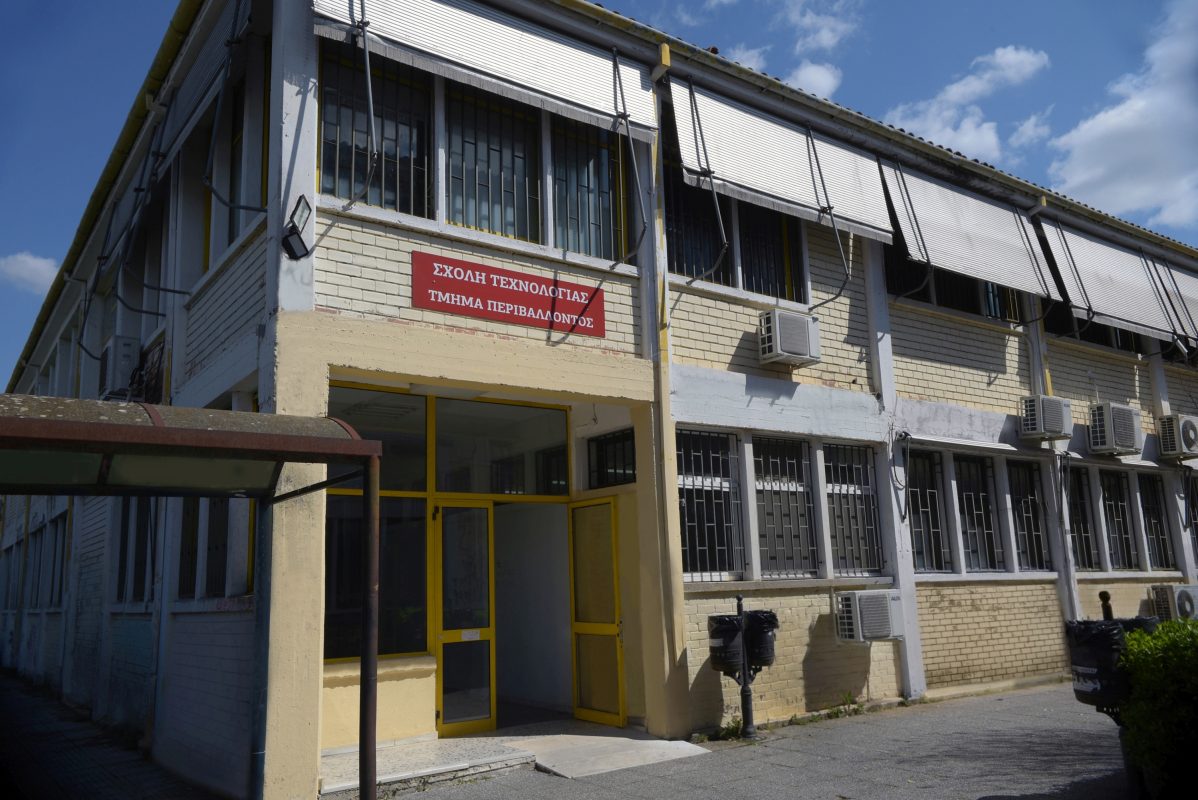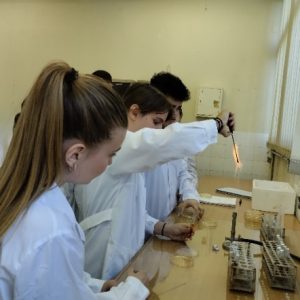“Water & wastewater quality assurance laboratory”

Department of Environmental Sciences
Lab E-mail: papapoly@uth.gr, spil@uth.gr, kakavas@uth.gr
Tel. +302410684330, +302410684428 & +302410684664
The laboratory started operating in 1991 and was gradually equipped with sufficient research equipment. Since 1993, research efforts have been made on environmental issues based on the equipment of Instrumental Chemical Analysis available to the laboratory. One of his achievements concerns the research and application of solid or liquid waste by integrating them in ceramics to create composites with advanced structure and utilization of waste produced by various processes, so that their safe disposal is resolved and the their residual value to be estimated. The Laboratory focuses on issues of circular economy and in particular on the detection of terms and conditions for the utilization of by-products and / or waste.
In recent years it specializes in the cultivation of microalgae. More specifically, research is done on microalgae (single-celled organisms) with the ultimate goal of producing biofuels and antioxidants. It investigates how the culture method, ie the type of bioreactor, the methodology of adding nutrients, macronutrients (nitrogen, phosphorus, potassium), micronutrients (trace elements) and other culture conditions, such as light quality and light intensity, temperature, pH and agitation affect the production of biomass, proteins, fats and antioxidants. In addition to autotrophic culture, research on the heterotrophic culture of microalgae using industrial waste is also carried out. Autotrophic cultivation helps in the biological capture of CO2 while, in the context of the cyclical economy, heterotrophic cultivation utilizes the macronutrients and micronutrients of industrial waste, such as outflows from biogas plants (biofertilizer).
The Laboratory also deals with issues of Heterogeneous photocatalysis. Heterogeneous photocatalytic processes involve irradiation–usually UVA (λ=320–400 nm) or solar irradiation–in the presence of a semiconductor as a catalyst for the production of free hydroxyl radicals which, have one of the strongest oxidative potential (E0=+2.8 V). The basic mechanismfor generating •ΟΗ involves the adsorption of a photon, the generation of an electron-hole pair and subsequently the production of •ΟΗ. The photo-generation of a hole-electron pair is a reversible process and it can therefore highly diminish the rate of •ΟΗ production. The generated electrons react with adsorbed oxygen and this inhibits the recombination step. Recombination of the hole-electron pair proceeds very fast. Therefore, oxygen is needed to slow down the recombination step. The process has been used in the laboratory for the degradation of dyes. It is efficient for the treatment only of dilute solutions (<200 mg/l).
Today the Laboratory focuses on quality control issues of surface, groundwater (irrigation – water supply), drinking, swimming, sea (blue flags), rain and thermal waters according to the World Health Organization, European and National legislation (JMD 38295/07, OA 98/83 EC). The control parameters concern both the chemical (organic compounds, Antimony, Arsenic, Boron, Bromates, Cadmium, Chromium, Copper, Cyanides, Fluoride, Lead, Mercury, Nickel, Nitrates, Nitrides, Set of pesticides, Organic, Polycyclic carbon [TOC]) and the microbiological analysis (Total Microbiological Flora, E.coli, Coliforms, Enterococci, Cl. Perfrigen, Pseudomonas aeruginosa) of water.
The Laboratory aims at the development of collaborations at national and European – international level, with simultaneous connection with both productive bodies and society.
The “Water Quality & Environmental Control Laboratory” includes the following areas / cells, which develop the relevant research activity and are the subject that covers, as follows:
SECTION A: ENVIRONMENTAL PROTECTION TECHNOLOGIES – BIOFUELS
Section A of the Laboratory focuses on the research and development of new environmental protection technologies, the production of biofuels from algae, as well as the recycling of primary sector waste through the technologies it develops.
SECTION B: QUALITY WATER and SOIL CONTROL & PUBLIC HEALTH
Sector B focuses on water quality and its impact on humans and public health protection in general.
Published scientific papers
1. K. Soutsas, V. Karayannis, I. Poulios, A. Riga, K. Ntampegliotis, X. Spiliotis, G. Papapolymerou “Decolorization and degradation of reactive azo dyes via heterogeneous photocatalytic processes” Desalination, 250(1), (2010), 345-350.
2.A. Riga, K. Soutsas, K. Ntampegliotis, V. Karayannis, G. Papapolymerou,‘’Effect of System Parameters and of Inorganic Salts on the Degradation Kinetics of Procion Hexl Dyes. Comparison of H2O2/uv, Fenton, photoFenton, TiO2/UV and TiO2/UV/ H2O2 processes’’, Desalination, 211, 72-86, 2007.
3.K. Ntampegliotis, A. Riga, V. Karayannis, V. Bontozoglou, G. Papapolymerou, ‘’Decolorization kinetics of Procion Hexl dyes from textile dyeing using Fenton-like reactions”, J. of Hazardous Materials, 136(1), 75-84, 2006.
4. Papaioannou A, Rigas N, Rigas G, Paliatsos A.G, Nastos P.T, Plageras P, Roupa Z, Kakavas K.V and Dovriki E. «Multivariate statistical interpretation of soil quality data in the context of public health». Fresenius Environmental Bulletin 2009, 18, 204-212.
5. Nastos P.T, Papaioannou A, Paliatsos A.G, Kakavas V.K, Plageras P and Dovriki E. «Wet deposition in two Greek sites: Larissa and Athens» Fresenius Environmental Bulletin. AcceptedJune 12 2008.Vol 17/No 10a/2008 –pages 1648-1654.
6. Papaioannou B.A, Plageras P,Dovriki E, Minas A, Krikelis V, Nastos PTh, Kakavas V.K and Paliatsos A. «Groundwater’s quality and location of productive activities in the region of Thessaly (Greece)». Desalination (2007) 213: 209-217.
7. Papaioannou Α, Kakavas K, Plageras P, Minas A, Roupa Z, Nastos P.Th. & Paliatsos A.G. «Multivariate Statistical Interpretation of Physical, Chemical and Microbiological Variables of Potable Water in the Context of Public Health». 5th WSEAS Int. Conf. on environment, Ecosystems and development. Tenerife, Spain, December 2007.
8. Papaioannou A, Kakavas V.K, Dovriki E.,Plageras P, Karamanis I, Papas M, Noulas A., Minas A., KrikelisV., Paliatsos A. «Quality control of groundwater of region Thessaly». Fresenius Environmental Bulletin (15/9/2006) 15(9a): 1015-1022.
9. Papaioannou Α, Plageras P, Dovriki E, Kakavas K, Nastos P.Th. & Paliatsos A.G. «Quality Control of Drinking Water and Public Health». WSEAS Transactions on environment and development ISSN 1790-5079(2006). June 2006, 6(2): 845-850.
10. Papaioannou A, Kakavas V.K, Plageras P, Dovriki E, Minas A, Noulas A. And Paliatsos A.G «Quality control of soils and groundwater of region Thessaly (Greece)». 8th International Conference on Protection and restoration of the environment. Chania, Greece, July 2006.
The main research laboratory activities are:
- Biofuels (biogas, biodiesel from the cultivation of microalgae).
- Smart proposals for water management and quality control
- Exploitation – incorporation of industrial waste and by-products into ceramic products.
- Energy recovery of industrial waste and by-products.
- Secondary raw materials development – exploitation derived from waste
Scientific research projects
- “Remazol dye discoloration experiments and correlation of experimental data” (ARCHIMIDIS I, 12-5-2004 to 31-12-2007).
- “Study of kaolin systems+graphite fibres, cement+flying ash, characters+mechanical properties + statistical analysis” (ARCHIMIDIS II, 01-01-2005 to 31-12-2007).
- “Study on the Development of Appropriate Technologies for Disposal-Management: Solid and Liquid By-products of Olive Oil Mills, Sewage Sludge, Alternative Solid Fuel (ASF) & Petroleum Coal (PETCOKE)”, 2011 – 2016 (Private financing).
- “Production of algae biofuels” (SYNERGASIA 2011, 1-1-2013 to 30-6-2015).
- “Innovation and Entrepreneurship Unit of TEI Larissa”, 2011-2013. EPEDBM, 2010-2013.
- “Study of the exploitation of deported refinery sludge and its bio-cleaning product in the construction ceramics industry” (16/12/2016 – 16/3/2017).
- “QUALITY CONTROL OF GAS, LIQUID AND SOLID EFFLUENTS OF THE BIOGAS UNIT SEITI BROS S.A. AND CERTIFICATION OF THE USE OF LIQUIDS AND SOLIDS EFFLUENTS IN AGRICULTURE”,2015 – 2019 (Private financing).
- “ASSESSMENT OF LIQUID WASTE FOR MICROALGAE CULTIVATION AND THEIR USE TO PRODUCTION OF BIODIEZEL AND FISH FEED SUPPLEMENTS” (code 5944), University of Thessaly.
- Coordination or Participation in various research projects in cooperation with enterprises and private bodies (INASCO SA, EXALCO SA, ΜΑΚΗ SA, “CHALKIS SA”, STUFFCOLOUR ENERGY SA, AIGAION SA, VIOKERAL SA, METALOCK, “ARGILOS” etc.).
The basic laboratory equipment available is as follows:
- Biochemical Oxygen Demand (BOD).
- Chemical Oxygen Demand (COD).
- Deionized water production apparatus.
- Electronic microscopy system.
- SPRaman-NIR Spectroscopy.
- Gas Chromatography.
- Total Organic Carbon.
- Ιοντική χρωματογραφία (IC).
- System (Anter) for the determination of specific thermal conductivity of materials.
- Blaine device.
- Vicat.
- Los Angeles.
- Infrared Thermo Balance apparatus for the determination of working plastic mass.
- Electronic penetrometers of various types to check the homogeneity of the materials produced.
- Pilot plant for the production of heavy clay ceramic materials with extrusion (milling, mixing-homogenization, formatting).
- Production of compressed ceramics.
- Atmospheric Dryer.
- Dryer using inert atmosphere.
- Electronically programmable oven for the firing of ceramics.
- High temperature Oven for thermal treatments (up to 1700cC).
- Water absorption measurement system.
- Automatic system for determining the resistance of materials to frost.
- Three-point bending.
- Complete system for studying mechanical properties.
- Hardness measurement (Rockwell).
- Determination of surface hardness for ceramic materials (Vickers).
- Ultrasound material failure control system.
- Measurement of a dynamic measure of elasticity using ultrasound.
- Acoustic wave device for determining defects.
- Surface grinding device.
- Density determination system.
- Balances.
- Raw material mixer.
- Ceramic test cutter.
- Bioreactors.
- Spectrophotometers.
- Dynamic Mechanical Analysis Device.
- Impact device.
- Leaching tests
Scientific Results
- Water quality monitoring and purification technologies
- Valorization of the solid and liquid industrial wastes.
- End of waste criteria in heavy clay ceramics production. Good practices developed in the Lab, accepted and published in the European Circular Economy Platform (https://circulareconomy.europa.eu/platform/en/good-practices/close-loop-ceramic-industry).
- Algae cultivation – biofuels production
Services provided by the laboratory to third parties:
- Services & consulting in Municipalities for quality control in drinking and other waters
- Services & consulting in Municipalities throughout Greece to support innovative ideas in agricultural and environmental issuesEnvironmental protection technologies – Biofuels.
- Industrial Research with emphasis on the development and pilot production of innovative products.
- Product Certification and Quality Control Services.
- Integrated solutions in the areas of Environmental Control and Protection.
- End of waste criteria – valorization studies.
- Detection of industrial symbiosis conditions.
- Advisory activity in the application of Quality Management Systems (ISO 9001), Environmental Management Systems (ISO 14001, EMAS), Drafting technical dossiers for CE marking, improving the quality of the products produced.
- Collaboration with organizations, local authorities, research institutes and related bodies.
- Specialized Workshops and Seminars.
- Training of Industry Personnel.
- Training of Scientists at Undergraduate and Postgraduate Level.
Personel
| Category |
Name | Tel. | |
| Director (Professor) | George Papapolymerou
(ΦΕΚ 698 τ. ΥΟΔΔ, 31-8-2020) |
papapoly@uth.gr | +302410684428 |
| Deputy Director (Professor) | Xenofon Spiliotis | spil@uth.gr | +302410684330 |
| Associate Professor | Efthimios Providas | providas@uth.gr | +302410684331 |
| Associate Professor | Nikolaos Gougoulias | ngougoulias@uth.gr | +302410684439 |
| Assistant Professor | Konstantinos Kakavas | kakavas@uth.gr | +302410684664 |
| Assistant Professor | Dorothea Kasiteropoulou | dkasiter@uth.gr | +302410684317 |
| Associate Professor | Tsiroukis Achilles | tsirouk@teilar.gr | +306948724751 |
| Assistant Professor | Dimitrios Papanastasiou | dkpapan@uth.gr | |
| Assistant Professor | Dimitrios Christodoulou | dchristo@uth.gr | 6978995598 |
| Researcher | Giannis Faraslis | faraslis@uth.gr | 6977482198 |
| Researcher (Ph.D.) | Stelios Lamprakopoulos | lamprako@otenet.gr | 6972831282 |
| Ph.D. candidate | Dimitra Kaffe | kaffedemi@gmail.com | 6979057519 |
| Researcher (M.Sc.) | Anastasios Mpesios | bes_tas@yahoo.gr | 6983904288 |
| Specialized personnel | Marina Lambronikou | mlampronikou@uth.gr | 6971899200 |
| Specialized personnel | Giorgos Soulis | soulis@uth.gr | 6981138562 |
| Specialized personnel | Evaggelia Gkani | gkanie@teilar.gr | 6976561301 |
| External partner
Chemical Engineer |
Papageorgiou Theophilos | 6972768100 |



















